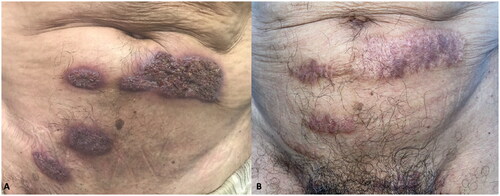Abstract
Background: Pyoderma vegetans (PV) is a rare neutrophilic dermatosis of unknown etiology. Currently, there are no treatment guidelines for PV. Systemic steroids are often used as first-line therapy, but recurrence upon discontinuation or tapering is common.Materials and methods: We tested the efficacy of doxycycline at a dose of 200 mg/d to treat resistant PV.Results: After 4 weeks of treatment we noticed a significant improvement in the clinical appearance of PV.Conclusions: Our case demonstrates the potential utility of doxycycline as a systemic steroid-sparing agent in the treatment of PV.
Introduction
Pyoderma vegetans is a rare neutrophilic dermatosis characterized by large verrucous plaques topped with pustules and raised borders, mostly located on the trunk, lower limbs, and intertriginous regions. Pyoderma vegetans is a rare variant of pyoderma gangrenosum, distinguished from its classical form by its clinical and histological appearance, and often the absence of associated pathology. We report the case of a patient with pyoderma vegetans who responded well to doxycycline with excellent results.
Case report
A 63-year-old patient with no previous medical history was followed in our dermatology department for 3 years for vegetative pyoderma, initially treated with oral corticosteroids at 0.7 mg/kg/day, optimized to 1 mg/kg/day, and later combined with dapsone 150 mg/day with topical corticosteroids. The patient did not improve under this treatment and even developed corticosteroid-induced femoral and lumbar osteoporosis. Clinical examination revealed crusty and violaceous verrucous plaques on the abdomen, pubic region, and buttocks. The rest of the clinical examination was normal. Multiple skin biopsies showed pseudoepitheliomatous hyperplasia, an infiltrate of neutrophils with eosinophils, and focal vascular lesions. Mycological, bacteriological, and parasitological examinations were normal. A complete workup was performed, including a complete blood count, serum protein electrophoresis, paraneoplastic panel, and colonoscopy to exclude Crohn’s disease, which revealed no abnormalities. Considering the history of osteoporosis, oral corticosteroid treatment could not be continued.
We could have suggested other treatments indicated for pyoderma vegetans, but the patient refused any treatment requiring restrictive clinical or biological monitoring, so we proposed doxycycline alone at a dose of 200 mg/day in two doses, which the patient received for 4 weeks ().
Discussion
Pyoderma vegetans is a rare type of neutrophilic dermatosis characterized by pseudoepitheliomatous hyperplasia with a mixed dermal inflammatory infiltrate and subcorneal abscesses containing neutrophils and eosinophils on histology. The etiology of pyoderma vegetans is unknown; however, some have suggested the role of bacterial infection in immunocompromised patients as a contributing factor (Citation1). Currently, there are no guidelines for the treatment of pyoderma vegetans. Oral corticosteroids are often used as the first-line treatment, but recurrence upon discontinuation or tapering is common. Other reported treatments in the literature include antibiotics such as penicillin, protected amoxicillin, ciprofloxacin, clindamycin, rifampin, dapsone, itraconazole, anti-TNFα agents such as infliximab, adalimumab, etanercept, immunosuppressants such as azathioprine, mycophenolate mofetil, methotrexate, cyclosporine, and systemic retinoids such as isotretinoin and acitretin (Citation2). To our knowledge, this is the second case in the literature describing the successful treatment of pyoderma vegetans with doxycycline (Citation3). In addition to its broad-spectrum bacteriostatic activity, doxycycline inhibits the chemotaxis of neutrophils, making it particularly useful in neutrophilic dermatoses such as vegetative pyoderma. Our case demonstrates the potential utility of doxycycline as a systemic steroid-sparing agent in the treatment of pyoderma vegetans. Furthermore, due to its low risk of side effects, it may be of interest in patients with comorbidities contraindicating more aggressive therapies. Nevertheless, further research is needed to identify the specific mechanisms of pyoderma vegetans pathogenesis and establish treatment guidelines for this rare disease.
Disclosure statement
No potential conflict of interest was reported by the author(s).
Additional information
Funding
References
- Dodd EM, Howard JR, Dulaney ED, et al. Pyodermatitis-pyostomatitis vegetans associated with asymptomatic inflammatory bowel disease. Int J Dermatol. 2017;56(12):1–2. doi: 10.1111/ijd.13640.
- Gara S, Souissi A, Mokni M. Pyodermatitis pyostomatitis vegetans. JAMA Dermatol. 2020;156(3):335. doi: 10.1001/jamadermatol.2019.3515.
- Reddy SB, Wang S, Graham LV. Successful treatment of pyoderma vegetans with doxycycline. JAAD Case Rep. 2022;21:10–13. doi: 10.1016/j.jdcr.2021.11.031.


